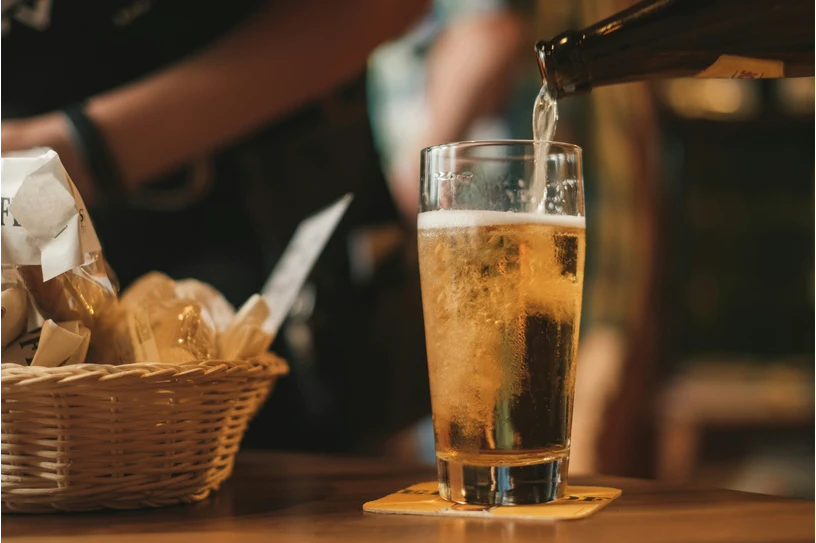Introduction – A Changing Approach to Social Drinking
It's a universal experience, laughter fills the air, glasses clink, and conversations flow. For generations, those glasses likely held wine, beer, or a cocktail, because alcohol has long been a key to how we unwind, celebrate, and connect. From happy hours to wedding toasts, a drink in hand has signaled relaxation and ease. But for many, that familiar ritual is starting to lose its appeal.
Younger generations, in particular, are rethinking alcohol’s role in their lives. Concerns about health, mental clarity, and the lingering effects of drinking are prompting more people to explore alternatives, options that still foster a sense of calm and connection without the downsides. They’re not just looking to avoid alcohol, they want something that enhances their experience in a meaningful way (1).
The functional beverage market has responded with a wave of new options, from CBD-infused sodas to adaptogenic mocktails. Yet many of these “alcohol alternatives” fall short, offering little beyond a pleasant taste or a fizzy texture. They don’t deliver the shift in mood or sociability that people crave, leaving a gap between expectation and reality.
This is where Kanna enters the scene. Scientifically known as Sceletium tortuosum, Kanna is a succulent plant used for centuries by Indigenous South African communities to enhance mood and foster social bonds. Modern research is now beginning to support these traditional uses, catching the attention of beverage innovators.
With careful formulation grounded in science and safety, Kanna-infused drinks may offer something unique in the wellness space: a tangible lift in mood and social ease, without the fog or regret of a hangover.
II. The Challenges of Alcohol and the Quest for Alternatives
Despite its deep cultural roots, alcohol is one of the most harmful substances consumed worldwide. The World Health Organization links it to over 200 diseases and injury conditions, contributing to millions of deaths annually (2). Even moderate drinking is associated with heightened risks of cancer, cardiovascular problems, and mental health issues (3).
Neurologically, alcohol alters the brain’s reward and stress systems. It temporarily increases levels of dopamine and GABA, chemicals tied to pleasure and relaxation, creating an initial sense of euphoria or calm. However, with repeated use, these systems adapt. Over time, alcohol can dampen the brain’s natural dopamine response, making it harder to feel joy or motivation without a drink. Simultaneously, stress hormones surge during withdrawal, triggering anxiety, irritability, or low mood as the effects fade (4).
These neurological shifts can impair decision-making, focus, and emotional regulation, particularly with frequent or long-term drinking. What begins as a tool for relaxation can gradually undermine emotional balance in daily life. Yet many people drink not for the physiological effects but because alcohol is woven into the fabric of social interaction. It’s common to hear someone say they need a drink to “loosen up” or feel at ease in a group. The act of drinking offers a socially accepted way to unwind, even if it comes with significant costs.
This tension has created a gap, especially among younger generations, where the desire for connection persists, but alcohol no longer aligns with their priorities. Market data reflects this shift: Gen Z and Millennials are driving a notable decline in alcohol consumption, embracing wellness-focused lifestyles and sober socializing instead (1).
The beverage industry has responded with non-alcoholic beers, botanical sodas, and CBD-infused drinks. While these check the “alcohol-free” box, many fail to provide a meaningful change in mood or mental state. Consumers are increasingly aware of this shortfall, seeking not just abstinence but functionality, something that feels good, acts quickly, and is backed by science. Forbes echoes this point, describing how the rise of functional drinks reflects a cultural shift — people want beverages that do more than taste good; they want them to help them feel calm, clear, and connected (5).

III. Enter Kanna: A Plant with a Purpose
Kanna, or Sceletium tortuosum, is a succulent native to South Africa, used for centuries by the Indigenous Khoisan people. Traditionally, it was harvested, fermented, and either chewed or brewed into tea to elevate mood, ease fear, and foster connection during communal gatherings or long hunts (6). These uses were not recreational in the modern sense but deeply functional, rooted in cultural practices aimed at emotional and social balance.
Recent scientific studies are beginning to align with this traditional knowledge. Researchers have identified key active compounds in Kanna — mesembrine, mesembrenone, and mesembrenol — that appear to influence brain systems tied to mood, stress, and mental clarity (7).
Kanna’s primary mechanism seems to involve acting as a serotonin reuptake inhibitor (SRI). Laboratory studies show that mesembrine binds strongly to the brain’s serotonin transporter (SERT), potentially increasing available serotonin levels (7). Another compound, mesembrenone, inhibits PDE4, a process linked to improved cognitive function and reduced anxiety in preliminary research (7).
Human studies are adding weight to these findings. In a double-blind, placebo-controlled brain imaging study, participants who took a single 25 mg dose of Zembrin®, a standardized Kanna extract, showed reduced amygdala activity when viewing fearful images. The study also noted decreased connectivity between the amygdala and hypothalamus, suggesting Kanna may dampen the brain’s stress response (8).
As more people look for mood-boosting options that work quickly and don’t involve alcohol or heavy sedation, beverage makers are beginning to see the potential of turning Kanna’s traditional use, and growing scientific support, into something you can sip and feel.
IV. The Rise of Kanna Beverages: A New Kind of Drink
As consumers seek beverages that go beyond flavor to support mood and wellness, Kanna is emerging as a standout ingredient. Beverage creators are developing a new kind of drink, one that honors the plant’s South African roots while leveraging scientific research to enhance social and emotional well-being.
Drawing on its traditional use by Indigenous South African communities brewing it into tea, Kanna is now finding its way into modern beverages designed to promote calm and connection. Both Zembrin® and KannaEase™, two standardized, research-backed Kanna extracts, are being used in sparkling tonics and even non-alcoholic beers, thanks to their stability and effectiveness in ready-to-drink formulations. For example, startups like Bodhi Bubbles are at the forefront, using Zembrin® alongside complementary ingredients like L-theanine or chamomile to create sippable blends that balance taste with a subtle, uplifting effect (9).
Several factors make Kanna particularly suited for beverage formulations:
- Reliable dosing: Standardized extracts like Zembrin® are lab-tested to ensure consistent mesembrine levels, providing predictable effects in every serving.
- Easy to formulate: Kanna extracts can be pre-dissolved or emulsified into beverage-ready formats, blending seamlessly into sparkling tonics, teas, or functional shots without affecting taste or texture.
- Clear regulatory path: Kanna is listed in the European Pharmacopoeia and is not a controlled substance in the U.S. or most global markets. Its regulatory clarity, combined with its long history of use, gives manufacturers confidence in product development.
Together, these advantages position Kanna as more than a supplement ingredient. It’s a culturally significant, scientifically supported botanical that aligns naturally with the growing demand for functional beverages.
V. Why Kanna May Succeed Where Others Don’t
The market is crowded with alcohol alternatives, from CBD sodas to mushroom tonics and adaptogenic blends. Yet in social settings, most people still seek the same outcome: a drink that helps them relax, feel good, and stay engaged, without the next-day fog. And Kanna may offer something uniquely suited to this need.
A Different Kind of Social Lubricant
Alcohol has long been a default for easing social tension, but its drawbacks — poor sleep, groggy mornings, and reduced control — are well-known. For those seeking social benefits without the trade-offs, Kanna presents a promising alternative.
Users often describe its effects as calm yet clear, fostering ease without dulling the mind. It supports relaxation while preserving mental sharpness, appealing to those who want to unwind while staying fully present.
Onset That Matches Real-Life Use
Timing is critical in social settings. Unlike many herbs that require weeks of use to take effect, Kanna may act within a single serving. Anecdotal reports suggest users notice a mood shift within 30 to 60 minutes (10), making it practical for real-time social support, a rarity among functional ingredients.
Clear-Headed Calm vs. Foggy Relaxation
Kava and CBD are popular for stress relief, but their effects can be inconsistent. Kava may cause drowsiness, while CBD’s impact is often subtle, leaving some users wanting more. Kanna’s dual action, affecting serotonin transport and PDE4 pathways, may deliver a more noticeable, mood-brightening effect without sedation (8).
In a 2013 placebo-controlled brain imaging study, a single 25 mg dose of Zembrin® reduced amygdala activity in response to fearful stimuli, indicating Kanna may ease social tension while maintaining mental clarity (8).
VI. Responsible Use, Transparency, and Future Potential
As Kanna gains traction in the wellness world, its story extends beyond its effects. It’s also about how it’s sourced, who benefits, and its broader impact. Some companies are leading by example. Afrigetics, the team behind KannaEase™, partners with rural South African communities to cultivate Sceletium tortuosum in ways that honor the environment and local expertise. Their benefit-sharing model ensures that the communities tied to this plant for generations share in its success (11).
Rather than relying solely on wild harvesting, their growers use sustainable practices like replanting cuttings and preserving root systems. These methods protect wild populations and support long-term cultivation.
Transparency is equally important. Standardized extracts like Zembrin® and KannaEase™ are rigorously tested for active compounds, ensuring that what’s on the label matches what’s in the bottle. This consistency builds consumer trust in an industry where vague claims are still common.
Ultimately, this approach is about more than a wellness trend. It’s about creating products that benefit both consumers and the communities behind them, while respecting the plant’s cultural origins.
Conclusion – A New Way to Connect?
For many people, the desire to relax, feel good, and connect with others hasn’t gone away, but the tools we use to get there are changing. As alcohol continues to fall out of favor, consumers are seeking experiences that support both mental well-being and conscious living.
Kanna beverages offer an exciting alternative, a drink that feels good, works quickly, and leaves you clear-headed. Rooted in centuries of traditional use and bolstered by emerging science, Kanna is carving out a space as a natural way to unwind and engage with others.
At its core, Kanna isn’t just a replacement for alcohol. It’s an invitation to rethink how we come together, fostering moments of connection that feel authentic, uplifting, and true to who we are.
References
- NielsenIQ (2023). Research on Gen Z and Millennial alcohol trends
- World Health Organization. (2018). Global Status Report on Alcohol and Health.
- Harvard T.H. Chan School of Public Health. Alcohol and Cancer Risk.
- Koob, G. F., & Volkow, N. D. (2016). Neurobiology of addiction: a neurocircuitry analysis
- Cording, J. (2025). The rise of functional beverages among Millennials and Gen Z. Forbes.
- Olatunji, T.L., Siebert, F., et al. (2021) Sceletium tortuosum: A review on its phytochemistry, pharmacokinetics, biological and clinical activities
- Harvey, A.L., et al. (2011). Pharmacological actions of the South African medicinal and functional food plant Sceletium tortuosum and its principal alkaloids
- Terburg, D., Syal, S., et al. (2013). Acute effects of Sceletium tortuosum (Zembrin), a dual 5-HT reuptake and PDE4 inhibitor, in the human amygdala and its connection to the hypothalamus
- Bodhi Bubbles. (2025). Functional sparkling drinks with Zembrin®
- Happy Herb Co. (2024). Kanna Profile: Onset and Use Cases
- Afrigetics. (2024). KannaEase™ Extract Page






